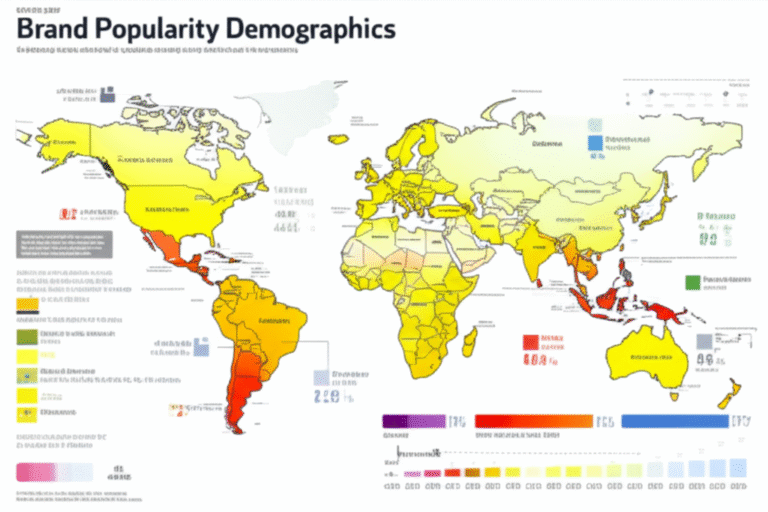Support our educational content for free when you purchase through links on our site. Learn more
10️⃣ Key Factors Driving Brand Success in the US Market (2025) 🚀
Ever wondered why some brands like Apple, Nike, and Patagonia seem to dominate the US market while others barely make a ripple? It’s not just luck or flashy ads — there’s a complex recipe behind their success that blends innovation, customer insight, storytelling, and much more. In this article, we peel back the curtain on the 10 essential factors that contribute to a brand’s triumph in America’s fiercely competitive landscape.
Here’s a teaser: did you know that 64% of US consumers consider a brand’s social responsibility when making purchases? That’s just one of the many surprising insights we’ll explore. Whether you’re a startup founder, marketer, or brand enthusiast, understanding these elements will help you craft a brand that not only survives but thrives.
Key Takeaways
- Product excellence and innovation form the unshakable foundation of brand success.
- Deep market research and consumer insights guide smarter decisions and targeted marketing.
- Compelling brand identity and storytelling create emotional connections that last.
- Exceptional customer experience and loyalty programs turn buyers into lifelong fans.
- Sustainability and social responsibility increasingly influence buying behavior.
- Agility, data analytics, and competitive analysis keep brands ahead of the curve.
- Strong leadership and company culture fuel innovation and resilience.
Ready to build your winning brand? Explore top products and brands that embody these principles:
- 👉 Shop Apple products: Amazon | Walmart | Apple Official Website
- Discover Nike athletic clothing: Amazon | Walmart | Nike Official Website
- Explore Patagonia gear: Amazon | Walmart | Patagonia Official Website
Dive in and unlock the secrets to brand greatness!
Table of Contents
- ⚡️ Quick Tips and Facts
- 🇺🇸 The Genesis of Greatness: Understanding Brand Success in the US Market
- The Secret Sauce: Key Factors for Brand Triumph in America
- 🚀 The Unshakeable Foundation: Product/Service Excellence & Innovation
- 🕵️♀️ Unlocking Consumer Insights: The Power of Market Research
- ✨ More Than a Logo: Crafting a Compelling Brand Identity & Storytelling
- 📢 Shouting from the Rooftops: Strategic Marketing & Omni-Channel Engagement
- ❤️ The Heartbeat of Success: Cultivating Exceptional Customer Experience & Loyalty
- 🚚 Getting It There: Robust Distribution & Accessibility
- 🌊 Riding the Waves: Agility & Adaptability to Market Shifts
- 🌱 Doing Good, Doing Well: Sustainable Practices & Social Responsibility
- 💰 The Sweet Spot: Smart Pricing & Value Proposition
- ⚖️ Playing by the Rules: Legal Acumen & Regulatory Compliance
- ⚔️ Outmaneuvering Rivals: Crafting Your Competitive Edge
- 📊 Leveraging Data & Analytics for Growth: Beyond Gut Feelings
- 🤝 The Power of Partnerships & Collaborations: Expanding Your Reach
- 🌪️ Navigating Economic Headwinds & Market Volatility: Staying Afloat
- 🧑💼 The Unsung Heroes: The Role of Leadership & Company Culture
- Conclusion
- Recommended Links
- FAQ
- Reference Links
⚡️ Quick Tips and Facts
Before we dive deep into the labyrinth of brand success in the US market, here’s a quick cheat sheet from the Popular Brands™ experts to get your gears turning:
- Success isn’t magic — it’s a blend of product quality, customer insight, marketing savvy, and adaptability.
- Market research is your compass — knowing your customers’ desires and behaviors is non-negotiable.
- Brand identity is your personality — it must be unique, memorable, and authentic.
- Customer experience is king — loyal customers are your best marketers.
- Sustainability and social responsibility increasingly influence buying decisions.
- Data-driven decisions beat gut feelings — analytics help you stay ahead.
- Competitive analysis reveals your secret weapons — learn from rivals to carve your niche.
- Leadership and culture shape your brand’s soul — a motivated team drives success.
Did you know? According to Leger’s 2022 study, 64% of consumers care about a brand’s social responsibility efforts. That’s a powerful nudge to do good while doing well!
For a broader perspective, check out our Top 100 US Brands feature — it’s a treasure trove of inspiration.
🇺🇸 The Genesis of Greatness: Understanding Brand Success in the US Market
To crack the code of brand success in the US, you need to understand what a brand really is. According to Investopedia, a brand is more than just a logo or a catchy slogan — it’s a distinct identity that sets a product or business apart from the crowd.
Think of brands like Apple, Nike, or Starbucks — they’ve built identities that resonate emotionally and practically with millions. This identity is crafted through design, packaging, advertising, and most importantly, consistent delivery of value.
Brand equity, or the commercial value of a brand’s reputation, is a key asset. It influences customer loyalty, pricing power, and even investor confidence. Some brands have survived centuries (hello, Stella Artois since 1366!), while others have faded into oblivion (RIP Toys R Us, though it’s making a comeback).
Understanding this foundation helps you appreciate why the factors we’ll explore next are so critical.
The Secret Sauce: Key Factors for Brand Triumph in America
1. 🚀 The Unshakeable Foundation: Product/Service Excellence and Innovation
Product quality is the bedrock of brand success. Without it, no amount of marketing can save you. According to a Deloitte survey, quality ranks among the top three reasons consumers pick a brand 86% of the time.
What does excellence mean? It’s not just durability or functionality — it’s solving a problem effectively, ease of use, aesthetics, and sometimes customization. Take Apple’s iPhone: sleek design, intuitive interface, and constant innovation keep customers coming back.
Innovation keeps brands relevant. Look at Tesla — it revolutionized electric cars with cutting-edge tech and bold vision. Innovation creates buzz, differentiates you, and often commands premium pricing.
| Aspect | Why It Matters | Example Brand |
|---|---|---|
| Product Quality | Builds trust and loyalty | Apple, Toyota |
| Innovation | Differentiates and attracts attention | Tesla, Amazon |
| Problem Solving | Meets real customer needs | Dyson (vacuum tech) |
| Aesthetics | Enhances perceived value | Nike (sneaker design) |
Pro Tip: Regularly test your products with real users and gather feedback. Continuous improvement is your best friend.
2. 🕵️♀️ Unlocking Consumer Insights: The Power of Market Research
You can’t hit a target you don’t see. Market research is your spotlight in the dark.
The Small Business Administration emphasizes how market research blends consumer behavior with economic trends to reduce risks and confirm business ideas.
Key questions to ask:
- Is there demand for your product?
- How big is your target market?
- What are their demographics and preferences?
- How saturated is the market?
- What pricing are customers willing to pay?
Methods include:
- Analyzing existing data (industry reports, census info)
- Conducting surveys, focus groups, and interviews
For example, Nike uses extensive market research to tailor products for different sports and demographics, ensuring their offerings hit the mark every time.
Remember: Market research is ongoing — consumer tastes evolve, and so should your insights.
3. ✨ More Than a Logo: Crafting a Compelling Brand Identity and Storytelling
Your brand identity is your personality — it’s how you want the world to see you. It includes your name, logo, slogan, colors, and tone.
But identity alone isn’t enough. You need a story that connects emotionally. Think of Coca-Cola’s timeless message of happiness or Allstate’s reassuring “You’re in good hands®” slogan.
Why storytelling?
- Builds emotional bonds
- Makes your brand memorable
- Differentiates you from competitors
Tips for crafting your story:
- Be authentic and consistent
- Highlight your mission and values
- Show how you solve customer problems
Brands that master storytelling, like Patagonia with its environmental activism, earn fierce loyalty and advocacy.
4. 📢 Shouting from the Rooftops: Strategic Marketing and Omni-Channel Engagement
Marketing is how you get your brand in front of people at the right time. The best brands use strategic, multi-channel approaches — from social media and influencer partnerships to traditional advertising and experiential events.
Omni-channel means your brand is everywhere your customers are — online, in stores, on mobile apps, and even through voice assistants.
Examples:
- Amazon uses personalized email, app notifications, and voice shopping via Alexa.
- Starbucks integrates mobile ordering with in-store experiences.
Marketing success tips:
- Know your audience’s preferred channels
- Use data to personalize messaging
- Keep your brand voice consistent across platforms
5. ❤️ The Heartbeat of Success: Cultivating Exceptional Customer Experience and Loyalty
A brand is only as strong as its relationship with customers. Exceptional customer experience (CX) turns buyers into raving fans.
Key CX elements:
- Responsive customer service
- Easy returns and support
- Personalized interactions
- Consistent quality
Loyalty programs like Sephora’s Beauty Insider or Starbucks Rewards incentivize repeat business and deepen engagement.
Why it matters: According to PwC, 73% of consumers say CX is a key factor in purchasing decisions.
6. 🚚 Getting It There: Robust Distribution and Accessibility
No matter how great your product is, if customers can’t find or buy it easily, success will be elusive.
Distribution channels include:
- Brick-and-mortar stores
- E-commerce platforms
- Wholesale partnerships
- Direct-to-consumer shipping
Accessibility also means availability across regions and demographics.
Example: Coca-Cola’s vast distribution network ensures its products are available in nearly every corner of the US.
7. 🌊 Riding the Waves: Agility and Adaptability to Market Shifts
Markets are dynamic — trends, technologies, and consumer preferences shift rapidly.
Brands that survive and thrive are those that adapt quickly.
Case in point: During the COVID-19 pandemic, Nike pivoted to online sales and digital fitness content, keeping engagement high despite store closures.
How to stay agile:
- Monitor trends and competitor moves
- Invest in flexible supply chains
- Foster a culture of innovation and learning
8. 🌱 Doing Good, Doing Well: Sustainable Practices and Social Responsibility
Consumers increasingly expect brands to walk the talk on social and environmental issues.
64% of consumers say social responsibility influences their buying decisions (Leger, 2022).
Brands leading the charge:
- Patagonia — environmental activism and sustainable materials
- Ben & Jerry’s — social justice campaigns
Benefits of sustainability:
- Builds trust and loyalty
- Attracts socially conscious customers
- Differentiates brand in crowded markets
9. 💰 The Sweet Spot: Smart Pricing and Value Proposition
Pricing is a delicate dance — too high, and you scare away customers; too low, and you erode perceived value.
Value proposition is what makes customers feel they’re getting more than just a product — it’s about benefits, quality, and experience.
Popular Brands™ insight: Brands like Apple command premium prices because customers perceive superior value in design, ecosystem, and status.
Pricing strategies include:
- Penetration pricing to gain market share
- Premium pricing for exclusivity
- Competitive pricing to match rivals
10. ⚖️ Playing by the Rules: Legal Acumen and Regulatory Compliance
Navigating the US legal landscape is crucial. Compliance with regulations on labeling, advertising, safety, and intellectual property protects your brand from costly lawsuits and reputational damage.
Trademark protection safeguards your brand identity — think of the iconic Nike swoosh or McDonald’s Golden Arches.
Ignoring legalities can be fatal — just ask brands that faced recalls or lawsuits due to negligence.
⚔️ Outmaneuvering Rivals: Crafting Your Competitive Edge
Competitive analysis is your secret weapon. The SBA highlights how understanding your competitors’ strengths, weaknesses, and market share helps you find your window of opportunity.
Steps to competitive advantage:
- Identify direct and indirect competitors
- Analyze their pricing, marketing, and product features
- Spot gaps or underserved niches
- Innovate or improve to fill those gaps
For example, Dyson disrupted the vacuum cleaner market by focusing on innovation and design where competitors lagged.
📊 Leveraging Data and Analytics for Growth: Beyond Gut Feelings
Data is the new oil. Brands that harness analytics can optimize marketing, forecast trends, and personalize customer experiences.
Popular Brands™ tip: Use tools like Google Analytics, CRM software, and social listening platforms to gather actionable insights.
Benefits:
- Better targeting and segmentation
- Improved product development
- Enhanced customer retention
🤝 The Power of Partnerships and Collaborations: Expanding Your Reach
No brand is an island. Strategic partnerships can open new markets, share resources, and boost credibility.
Examples:
- Nike x Apple collaboration on fitness tech
- Starbucks and Spotify partnership to enhance in-store experience
Collaborations can create buzz and deliver value beyond what either brand could achieve alone.
🌪️ Navigating Economic Headwinds and Market Volatility: Staying Afloat
Economic downturns, supply chain disruptions, and changing consumer spending can threaten brands.
Successful brands build resilience through:
- Diversified product lines
- Flexible supply chains
- Cash reserves
- Agile marketing strategies
Example: During the 2008 recession, McDonald’s thrived by offering value menus and comfort food.
🧑💼 The Unsung Heroes: The Role of Leadership and Company Culture
Behind every successful brand is a visionary leadership team and a strong company culture.
Why it matters:
- Inspires innovation and accountability
- Attracts and retains talent
- Aligns employees with brand values
Popular Brands™ anecdote: We’ve seen startups with great products fail due to toxic culture, while humble companies with strong values scale rapidly.
Conclusion
Phew! We’ve journeyed through the intricate landscape of what makes a brand truly successful in the US market. From the unshakable foundation of product quality and innovation to the heartbeat of customer experience and loyalty, every factor plays a vital role in building a brand that lasts.
Remember, success is not a one-time event but a continuous dance — adapting to market shifts, embracing social responsibility, and leveraging data to stay ahead. The brands that win are those that listen to their customers, tell compelling stories, and play smart with pricing and legal compliance.
If you’re inspired by giants like Apple, Nike, or Patagonia, take a page from their playbooks: invest in quality, be authentic, and never stop innovating. Your brand’s story is waiting to be told — make it unforgettable.
Recommended Links
👉 CHECK PRICE on:
- Apple Products: Amazon | Walmart | Apple Official Website
- Nike Athletic Clothing: Amazon | Walmart | Nike Official Website
- Patagonia Outdoor Gear: Amazon | Walmart | Patagonia Official Website
- Dyson Vacuum Cleaners: Amazon | Walmart | Dyson Official Website
Recommended Books on Branding and Marketing:
- Building a StoryBrand by Donald Miller: Amazon
- Contagious: Why Things Catch On by Jonah Berger: Amazon
- Made to Stick by Chip Heath & Dan Heath: Amazon
FAQ
What role does cultural adaptation play in a brand’s ability to succeed in the US market?
Cultural adaptation is crucial in the diverse US market. The US is a melting pot of ethnicities, languages, and values. Brands that tailor their messaging, product offerings, and customer experiences to resonate with different cultural groups gain a competitive advantage.
For example, McDonald’s offers localized menu items like the McArabia in Middle Eastern markets and has marketing campaigns that celebrate cultural holidays and values. Ignoring cultural nuances can alienate potential customers or cause brand missteps.
By embracing cultural adaptation, brands show respect and relevance, which fosters trust and loyalty.
How does a brand’s online presence impact its success in the US, and what digital marketing strategies are most effective?
In today’s digital-first world, a strong online presence is non-negotiable. Consumers research products online, read reviews, and engage with brands on social media before making purchases.
Effective digital marketing strategies include:
- SEO and content marketing: To be discoverable when customers search.
- Social media engagement: Platforms like Instagram, TikTok, and Facebook help build community and brand personality.
- Influencer partnerships: Authentic endorsements can boost credibility.
- Email marketing and personalization: Delivering tailored offers and content.
- Omni-channel integration: Seamless experience across web, mobile, and physical stores.
Brands like Amazon and Nike excel by combining these strategies with data analytics to personalize customer journeys and optimize conversion rates.
What are the most important demographic factors for brands to consider when entering the US market, and how can they effectively target their desired audience?
Demographics such as age, income, education, ethnicity, and geographic location shape consumer behavior and preferences.
For example, targeting millennials requires different messaging and channels than targeting baby boomers. Urban consumers may prioritize convenience and trends, while rural consumers might value durability and price.
Effective targeting involves:
- Using market research to identify and segment audiences.
- Crafting tailored marketing messages that address specific needs.
- Choosing the right distribution channels to reach those segments.
- Continuously monitoring and adjusting strategies based on feedback and data.
Brands like Sephora use detailed demographic insights to personalize product recommendations and marketing campaigns.
What sets the most popular brands in the US apart from their competitors, and what can other brands learn from their successes and failures?
The most popular US brands share several traits:
- Consistent product quality and innovation that meet or exceed customer expectations.
- Strong, authentic brand identities that connect emotionally.
- Exceptional customer experiences that build loyalty.
- Agility in adapting to market trends and disruptions.
- Commitment to social responsibility aligning with consumer values.
Failures often stem from complacency, ignoring customer feedback, or failing to innovate. For instance, Blockbuster’s downfall was partly due to ignoring digital trends that Netflix capitalized on.
Other brands can learn to stay customer-centric, invest in innovation, and embrace change to avoid similar fates.
How important is leadership and company culture in sustaining long-term brand success?
Leadership sets the vision and tone, while company culture shapes how that vision is executed daily.
Strong leadership inspires innovation, accountability, and resilience. A positive culture attracts talent, fosters collaboration, and aligns employees with brand values.
Brands like Google and Zappos are known for their empowering cultures, which translate into superior products and customer service.
Neglecting culture can lead to internal conflicts, high turnover, and inconsistent brand experiences.
Reference Links
- Small Business Administration: Market Research and Competitive Analysis
- Investopedia: What Is a Brand?
- Business.com: 6 Reasons Why Product Quality Matters – Marketing
- Leger: Corporate Social Responsibility Consumer Impact
- Apple Official Website
- Nike Official Website
- Patagonia Official Website
- Dyson Official Website




